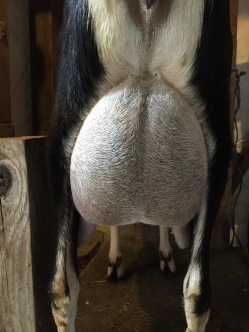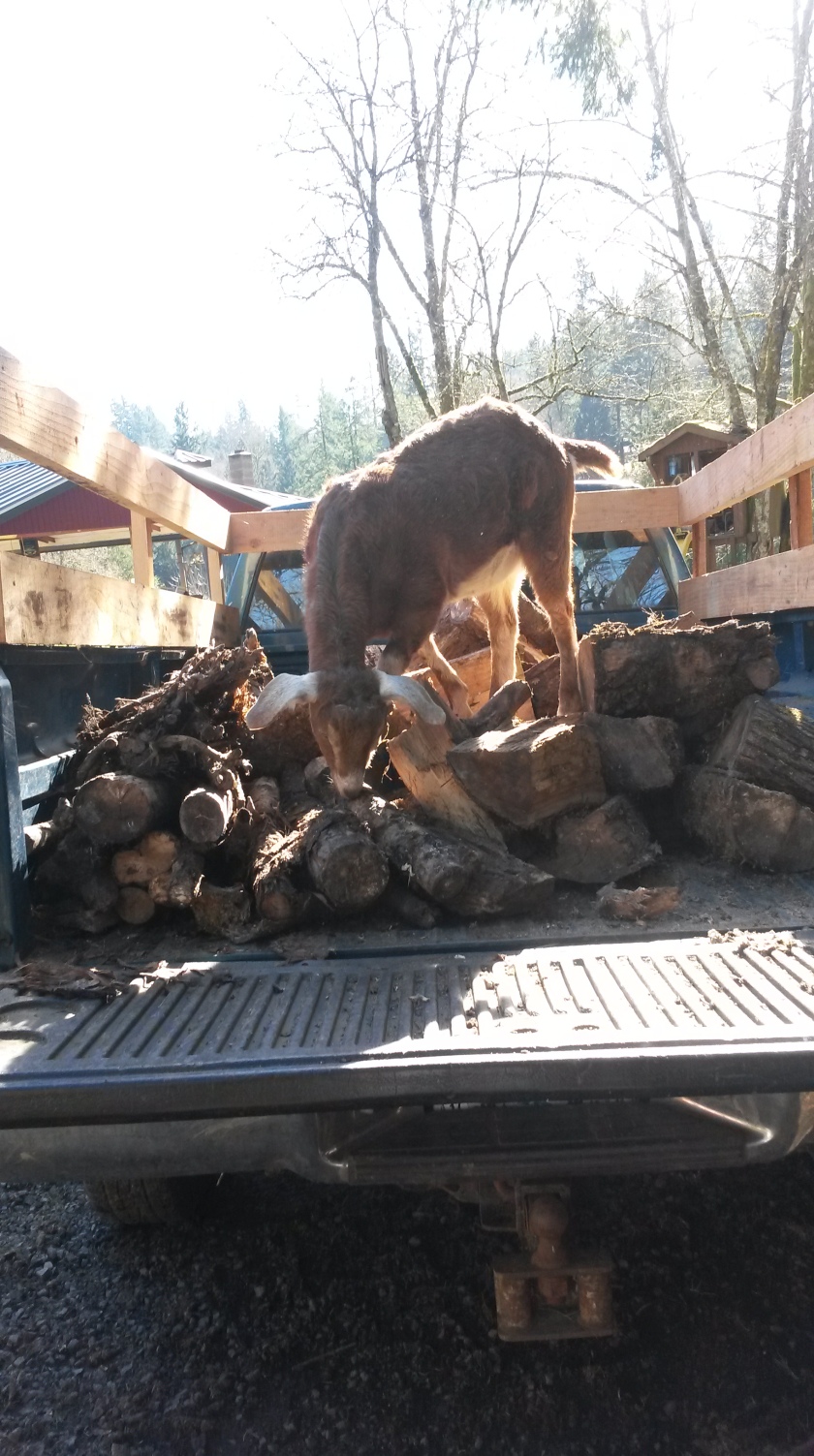Cocoa was born March 8th, 2006. She wasn’t born as mine. When I went to fair that year, it was decided it was a good idea that I have a companion for a kid I was showing from Tsornin (my first goat), so she wouldn’t be alone in the pen. My goat neighbor offered me one of hers as a companion – an offer that quickly turned into an offer of ownership. At that point, I’d worked so much with this neighbor I had vastly paid off what my goats were worth and their upkeep.
After spending a few hours picking out a kid, I settled on Cocoa.
Naming Cocoa was a little bit of a joke. Cocoa’s mother’s name was Elusive, so I wanted to do something ethereal or magic-like. But she was also the color of dark chocolate, and had a little white Hershey’s kiss on her forehead. As I was 14 years old, Mystical Cocoa became the perfect name of choice.
It wasn’t until fair came and went that I decided I would keep Cocoa. Not only had she shown incredibly well – winning Junior Champion – but there was something about her, personality and conformation, that really drew me. I decided to sell the other kid instead, and keep Cocoa.
It was the next year that Tscout, my showmanship goat, died by an unknown illness a few weeks after kidding. Cocoa was actually the one to go with Tscout to the vet, just in case they needed to keep her overnight and needed a companion. That evening, I ended up staying all night holding Tscout until she passed in the early morning.
Cocoa became my showmanship animal. Little did I know, she’d be excellent at it.

Not only did she have a conformation that barely needed any work, but after the first few minutes of stubborn fighting, she’d be docile – peeved, but docile all the same.
It wasn’t just me, either. The first year I was got into Master Showmanship I fretted over her behavior – and she was a complete angel to everyone who needed to show her.
Which is pretty laughable, but she was so stubborn every other day of the year, and threw her (considerable) weight around to get what she wanted.
* * *
I didn’t see Cocoa for most of my college years, as I had a dreadful falling out with the neighbors I worked for, and who technically owned my goats.
It was because of Cocoa that I decided to pursue legal action to get my goats back. I saw her at fair a few months after the split, and it just hit me: this wasn’t fair. I had worked so hard for them, and in my naiveté, thought the verbal arrangement we had would be honored.
And Cocoa was my baby.

The case took a long time. I think it was almost four years where I wasn’t in her life. During fair times I was able to sneak over and see her, and occasionally I’d see her in the neighbor’s pasture if the goats were out that day. I learned later that she was continually shown, and won quite a few ribbons.
My court case was settled in March, and she was returned to me a few weeks after she turned 8 years old. My dad and I loaded Cocoa and Phe (the only daughter of Cocoa’s that was returned) into the truck and drove them home. My mother cried when she saw us coming down the driveway.
It was immediately apparent Cocoa was not in good health. While Phe was nervous and half-delighted with the attention while furiously inspecting her new home, Cocoa stood in the corner of the pen and shook.
It took almost a month to find out what was wrong. She would barely eat, was incredibly skinny, and looked miserable constantly. My mother and I problem solved for weeks, coaxing her with interesting food and treats, syringing water into her to keep her from being dehydrated, giving her vitamins and antibiotics. I was on the phone with the vet almost every other day. It didn’t help that she was also depressed – I imagine it was a shock going from a herd of 40+ to a herd of 2.
I started gaining her trust and affection again by giving her scratch fests. For some reason she was itchy all the time – and loved to be scratched. My mom used to give her little massages, too.
Finally, almost a month later, we found some results: not only did she have a raging staff infection, was CAE positive, had no front teeth, and her stomach wasn’t working – she was hypocalcemic, which explained the shaking and the dull behavior.
Of course, she wouldn’t be nice and eat her alfalfa like a good goat (probably because it hurt to eat). And the calcium shots we were given stung horribly, and she definitely refused to eat whatever mouthfuls we could coax out of her after that. We tried to use liquid calcium, but had a find a very particular one – because most calcium supplements burn their mouths and cause sores.
Between the shots we’d given her before giving up, the new liquid calcium, and stuffing probiotics down her throat, she started to improve. I used to spend hours collecting tasty tidbits and taking her and Phe on walks. Cocoa’s health habits were a regular conversation at the dinner table.
The stress of the move and her health had caused some of the CAE symptoms to flare up, and her knees were twice their normal size. We started feeding her particular herbs to help combat the arthritis that the CAE was causing. The herbs helped enormously; even decreasing the amount of swelling that had occurred. To this day I still think those herbs prevented her from becoming crippled and needing to be put her down.

Phe kidded a little over a month later, and that helped Cocoa, too. At first she wanted nothing to do with those little buck kids; then she flipped and started guarding them like she was the mom herself. She was getting a little herd back.

I bought Sari in September a few months later as a graduation present to myself. As much as Sari is a butthead, she helped Cocoa’s attitude too. Sari wanted to go outside in their pen all the time (whereas Cocoa wanted to hide inside) and liked to explore. When Phe would follow Sari on her adventures, Cocoa was forced to go with and get out in the world.
Cocoa was a bit of a nut. When out for walks, she’d harass trees and bushes by twirling her head around and around a branch until it was nothing but pulp. For some reason, she’d take great enjoyment out of that.
She also loved the sunshine – man, did she love the sunshine. Even to the point of giving up food. She’s stand in it for hours, eyes half-closed.
We often joked about feeding Cocoa anxiety meds, because she was always fretting. She was herd boss, and would spend much of her time surveying the land, evil-eyeballing the dog and keeping track of all herd members.
Her favorite food was ferns. Back when she would barely eat anything, often a few fern leaves were the only thing she would eat. Second to that, it was the tender blackberry shoots – but then again, every goat wants to eat that.
During the winter, we started to tease her that she was a sheep. She would develop an undercoat so thick it looked like wool. It came off in great swaths during the spring that looked like cotton-dandelion-fluff spread everywhere.
* * *
Almost a year later, the goats and I moved to go live with my partner about a half an hour away. Cocoa was in good health, albeit high-maintenance. She didn’t like the move, of course…

… but her herd soon blossomed, bringing Blackberry, Duchess, and Sassy into the fold.
Now, at this new place, there was a run that the goats had to go down to get into the pasture. Cocoa, being the anxiety animal, refused to go out that way – and since she’s herd boss, nobody else would go either.
Cue much time spent leading Cocoa down the run to convince them to all go out in the sunshine and grass. It took a while, but between Sari and I, we got her straightened out.

She proceeded to be spoiled (as if she wasn’t before). I buy several types of grain, hays, and sunflower seeds – all of which she had access to. She was let into the feed room to free range, and privilege no other goat has had yet.
Being the ever-watchful one, she was always keeping track of all barn activity. During feeding times she’d spend half her time focused on what you were doing instead of what she should be eating. And at the end of chores, she’d escort you to the gate. Unless it was raining or too muddy, then she’d just watch you go.
She earned the nickname “Mama Drama” from my partner. Probably due to the always watching.
She also loved to be brushed, probably for the same reason as her weird itchiness. The expression on her face when she was brushed or itched was pure bliss.
* * *
Around February, almost two years after she came back to me, she started to get a little quiet. It was obvious by her behavior that she was no longer herd boss. She was getting thin again – but still healthy, with a glossy coat.
She started turning up her nose at the food. At first I figured it was because she was old, and didn’t want to fight the others for it. She started getting her own food, away from the others, with the new babies – Maggie and Aztec – for company. I also started bringing her oatmeal and honey, which she wolfed down – but wasn’t much interested in anything else.

Then, one day when I was looking through our wood picking out good pieces to build a duck house, I heard a loud THUMP-THUMP. The bucks slam into things all the time, but it sounded different.
She was on her side when I looked. It looked like she’d just fallen over, just like that. It was probably a stroke.
I’m just so grateful it was fast.
She didn’t move when I reached her. I was there for her final gasps of breath, but I don’t know if she recognized me. I hope she did; I hope she knew I was there, and she heard me when I told her over and over how much I loved her.
She’s buried next to Tscout, on my parent’s property, almost exactly two years after she was returned to me.
Cocoa died March 16th, 2016, in the afternoon, with the sun shining down on her.




























